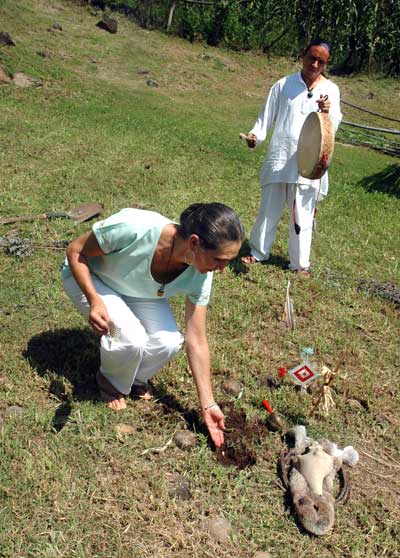EL JARDIN MESTIZO
Teuchitlán school teaches prehispanic gastronomy
By John and Susy Pint
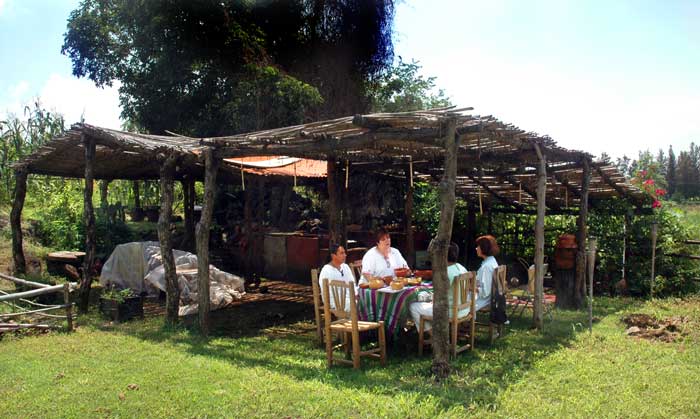 Archeologist Rodrigo Esparza was the one who told us about a
curious place called El Jardín Mestizo—located just below the Guachimontones or
circular pyramids of Teuchitlán. “They teach prehispanic cuisine,” he said, and,
of course, we were immediately curious to find out what people ate back when
Teuchitlán was the center of a huge empire.
Archeologist Rodrigo Esparza was the one who told us about a
curious place called El Jardín Mestizo—located just below the Guachimontones or
circular pyramids of Teuchitlán. “They teach prehispanic cuisine,” he said, and,
of course, we were immediately curious to find out what people ate back when
Teuchitlán was the center of a huge empire.
“For one thing,” said Rodrigo, “We found traces of their
tortillas. These were made of a mixture of corn and amaranth and were
beautifully decorated with cochineal.” Grana cochineal is the celebrated red dye
which—after gold—was the most sought-after commodity that the Conquistadores got
their hands on in the new world. This crimson dye is non-toxic and is made from
the crushed bodies of tiny insects (Dactylopius coccus) which spend their lives
sucking the juices of the prickly-pear cactus (nopal). Cochineal, it seems, is
making a big come-back because it is edible, whereas many synthetic red dyes are
now thought to be carcinogenic.
We immediately asked where we could buy “authentic” tortillas
and were amazed to learn that they are not for sale anywhere in Mexico. “If you
want to try the real thing, go visit the school,” said Rodrigo. So, we made an
appointment and drove out to El Jardín Mestizo, which turned out to be an
open-air kitchen under a thatched roof, surrounded by gorgeous flowers and
plants. Here we were warmly received by Maru Toledo and Godofredo Oseguera,
co-directors of the Research Center for the Rescue of the Oral Tradition and
Gastronomy of the Valles Region of Jalisco.
|
While Maru explained how this unusual school got its start,
Godofredo handed us bowl-like gourds filled with a cool, refreshing drink
unlike anything we had ever tried before. “It’s chocolate-and-barley juice,”
he told us; “I hope you like it.”
|
 |
|
WOW!
How did the
chocolate-and-barley drink taste? One look at Susy is enough to answer the
question.
|
 |
Well,
while sipping this delicious drink, we listened to Maru’s story. She told us she
had spent two years living in Ahualulco before it occurred to her to take a look
at Teuchitlán. When she did, she found the pueblo and its Guachimontones
enchanting and immediately decided to promote them on her radio program (see
below)...
| ...Maru
brought a group of people out to Teuchitlán and they spent the day touring
the place. They ate with the locals and in the evening participated in a
traditional Wixarica (the word which Huicholes use to refer to themselves)
ceremony called the Ritual of the Shell, which takes place inside a large
circle made of sage leaves. A small hole is dug in the center, into which
each participant places a few kernels of corn. A clay horn exactly
resembling a conch shell is then blown four times as the participants face
the four cardinal directions. After the ceremony, while eating tamales and
drinking atole, Maru met Godofredo Oseguera and they quickly discovered they
had much in common...
Although it looks just like a conch shell,
this horn is an ancient artifact, and still makes music.
|
 |
Godofredo had a small bit of property near the pyramids and
they went to have a look at it. Sitting on two tapixtles (reed mats which have
been used in Teuchitlán for ages), they discussed what they might be able to do
with the place. Maru explained that she had spent years trying to rescue the
gastronomy of the great haciendas in the area and said, “I wonder if we could do
something similar for the gastronomy of the Teuchitlán Tradition…” and because
Godo had been studying the ancient customs of the area, they found they had a
project to which they could both contribute...
|
 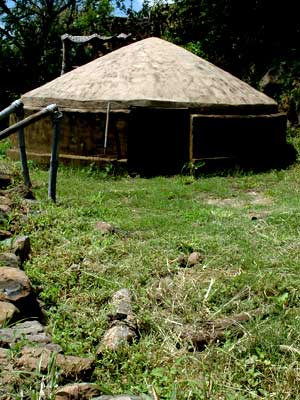
“...In fact,” said Godo, “every ingredient, every procedure, every
aspect of Wixarica cooking has some esoteric meaning, which is often
difficult, if not impossible for us to understand.”
Godo told us he had first imagined using his property to
build a temazcal (ritual steam bath) and some cabins, but the idea of
the cooking school grabbed him even though he had zero experience in
cooking, but “loved to eat.”
Left:
Ahuilotes berries make a tasty dessert.
Right: Godo eventually built his
temazcal too. |
“Actually, my real experience is in bartending,” he said,
“but I was missing something in my life and thanks to Maru I’ve found it.”
Maru told us that the first big meal they cooked at El Jardín
Mestizo was “buried chickens” and they turned out to be a big success.
Rodrigo Esparza explained to us that hundreds of years ago, it had been
common to cook wild turkeys by wrapping them in maize leaves, coating them
with a thick layer of clay and baking them in hot coals, underground. Maru
and Godo followed this ancient procedure and say that when the clay casing
is cracked open, a marvelous aroma fills the air and the meat turns out
unbelievably tender....
|
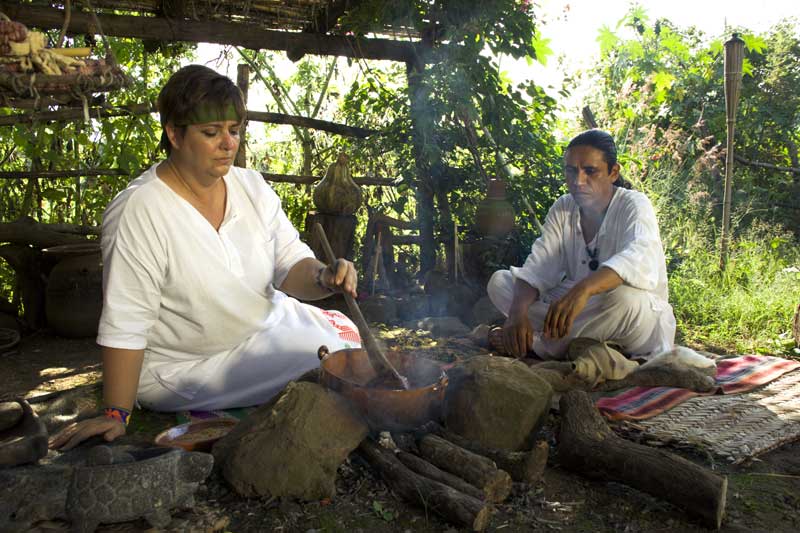 Photo
by Armando Gonzalez Nájera |
“Our capital at the beginning was 5000 pesos,” continued Maru.
“We would not have gotten anywhere if it weren’t for a lot of very kind people
who provided things and said we could pay for them later. Then we got a huge
boost because our very first course was attended by a lot of foreign chefs, who
heard about it on my radio program.” Maru Toledo’s program, Cuando Los Angeles
Cocinan (When Angels Cook) can be heard in Guadalajara 10-11 AM, Monday to
Friday on XEMIA-AM Noticias, 850 Khz.
 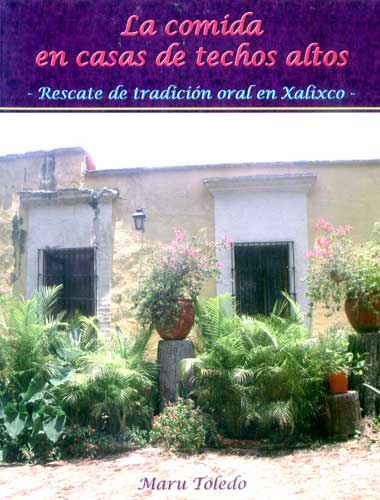 Left: Left:
The Original Corn. Three fully mature
ears aren't nearly as big as one ear of modern corn.
Right:
Besides rescuing the gastronomy of
pre-Hispanic times, Maru Toledo has collected recipes from Colonial
Mexico.
Her new book, "Food in Houses with High Ceilings"
is dedicated to the rescue of oral tradition in Jalisco. In order to get
you to appreciate what life was like in the old days, each recipe
introduces you to some intriguing character or curious custom from the
days of the great haciendas. We invite you to
take a peek
inside this most unusual cookbook. |
What could you learn to cook if you take a course at the
Jardín Mestizo? Well, beside corn, amaranth and cochineal tortillas, how about
frogs’ legs in pumpkin seed oil or mushrooms cooked in mesquite, chiles and
pulque?
|
You might wash all of the above down with a drink of tushi,
a tequila-like liquor distilled from the small sotól agave, and
finish up with a bowl of sweet ahuilotes (see above) which look
something like black berries, but have their own delicious flavor. Just in
case you put on too much weight trying out your new recipes, you can steam
it away in a traditional temazcal, located right next to the cooking school.
And you will probably end your experience participating in the moving Ritual
of the Shell.
...Godo
demonstrates the alambique (still) he built following
Wixarica
instructions ..
|
 |
You can phone Maru Toledo at 044 333 839 9941 or
contact us and we'll forward an email
to her.
 Archeologist Rodrigo Esparza was the one who told us about a
curious place called El Jardín Mestizo—located just below the Guachimontones or
circular pyramids of Teuchitlán. “They teach prehispanic cuisine,” he said, and,
of course, we were immediately curious to find out what people ate back when
Teuchitlán was the center of a huge empire.
Archeologist Rodrigo Esparza was the one who told us about a
curious place called El Jardín Mestizo—located just below the Guachimontones or
circular pyramids of Teuchitlán. “They teach prehispanic cuisine,” he said, and,
of course, we were immediately curious to find out what people ate back when
Teuchitlán was the center of a huge empire.








